In this module, we’ll discuss Tables, a very powerful feature that helps you develop very robust integration solutions. Tables provide a convenient way to aggregate important data and have it persist across any and all Flows that you create!
Course Material
In this module, we’ll discuss Tables, a very powerful feature that helps you develop very robust integration solutions. Tables provide a convenient way to aggregate important data and have it persist across any and all Flows that you create!
Overview
In this module we’ll discuss Tables, a very powerful feature that helps you develop very robust integration solutions.
Note that the video portion of this module will largely show demonstration and lead you through exercises which you’ll find written out in detail within the associated Workbook. Below are details about Tables that will help you gain familiarity with the interface such that you can complete the exercises.
Why Tables?
There are many operations that you need to perform within your Flows. As an example, perhaps you need to lookup a value and aggregate data from different sources to prepare a report.
While you can always leverage “middleman” applications such as spreadsheets or databases applications to address this issue with your integration solution, these methods require authentication and can take time.
Tables provide a convenient way to aggregate important data and have it persist across any and all Flows that you create!
Tables help with many scenarios such as: Counters, Synchronizations, High-Speed Lookups, Filters, temporary state storage while Flow are in process, and communicating between independent executions.
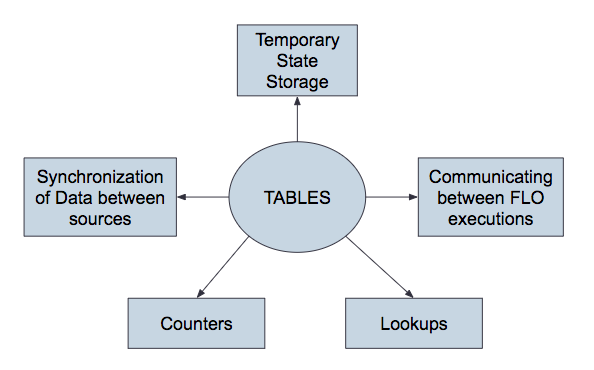
Creating and Editing Tables
To create a new table:
- Navigate to your Tables (Home >> Tables)
- Click the “+New Table” button

Name your table! Best practice is to use a naming convention that helps you quickly find and understand what your table would be used for. By default is will be set to “Unnamed” unless you change it. Clicking the field allows you to set the name.
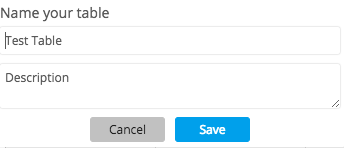
Table Field Types
Fields within tables come in multiple types which follow field types elsewhere in Designer. They are:
- String
- Number
- Date
- True/False (also known as “Boolean”)
- Counter
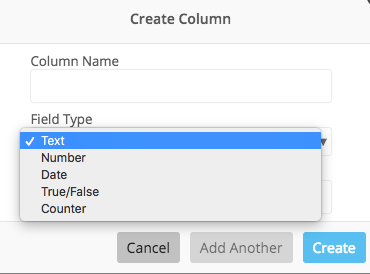
The “Counter” field type is used for fields where the updates will all be adding to (or subtracting from) the current value. The advantage of using a counter field is that multiple Flows can make updates to the same record at the same time without worry of conflicts or loss of data.
Working With Columns
Designer gives you the tools to add, edit, and sort columns as you’d expect.
To Add a Column:
- For each column you wish to add, click “+New Column”.
To Edit a Column:
- Click the gear icon next to the column to edit it.
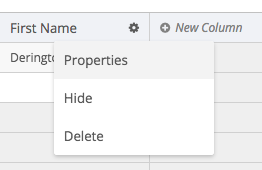
As with most spreadsheet-style applications, you have access to standard functionality such as:
- Resizing columns by dragging the right border of the column header
- Sorting by clicking a column header (clicking again reverses sort order)
- Re-Ordering columns by draging and droping column headers
- Filter records that match your search criteria via the “Filter” button
Additionally, you can control display of each column (hide/show) via the “Columns” option.
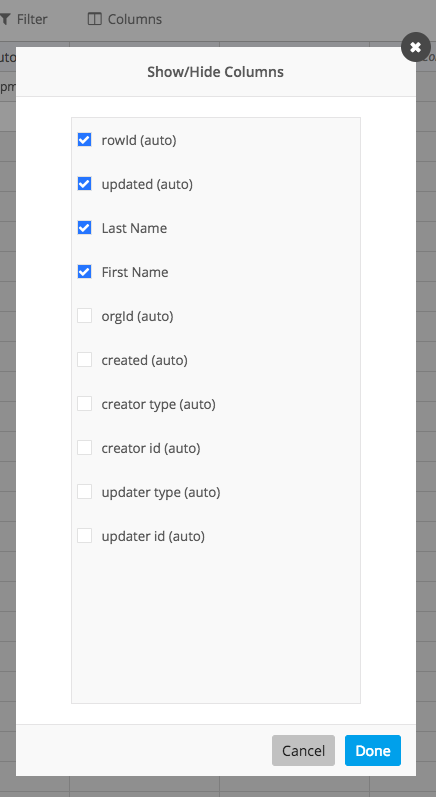
Import and Export
As with many tools, you can easily import and export your data
- Click “Import” to read data into the table from a CSV file
- Click “Export” to create a CSV file from the data

Adding, Editing, and Deleting Records
You can also easily manipulate content within your table.
- To add or edit, click in a row and then enter or edit the values in a field (or record)
- To delete a row, click the red trash can button

NOTE: Fields that include “(Auto)” are automatically generated and cannot be edited, e.g. the row ID or creation date.
Duplicating or Deleting a Table
To duplicate or delete a table, view it in My Flows or whatever folder it lives in and choose the appropriate button when you move your mouse over the table name. If you want to share a table with other users in your organization, place it inside a shared tab. (For more details on sharing, read Sharing Flows.)

Common Table Cards
Designer offers a number of cards to work with your Tables.
To work with a table from a Flow, add function cards from the “Tables” category when you click “Add Function.” Function cards allow you to create, read, update, and delete records from one of your tables. Click the help button at the bottom of any card for specific help on how to use that card.
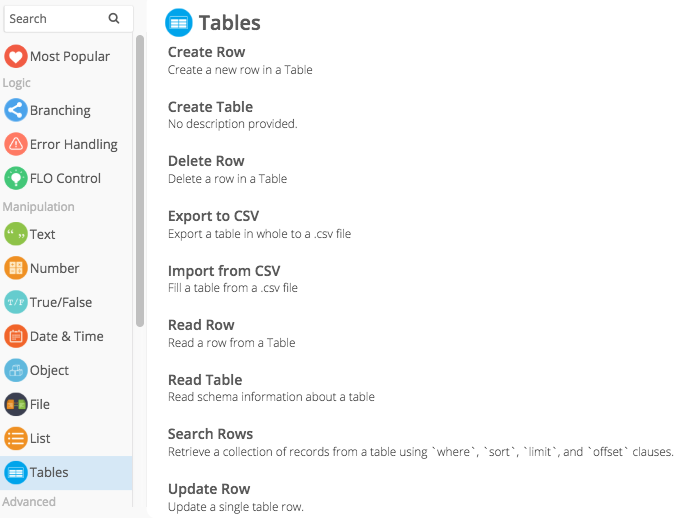
Notes and Limitations
Tables are:
- Exportable to CSV
- Scalable - up to 100k rows (depending on your plan)
- Responsive - All changes you make to a table are saved immediately
Maintain Your Tables:
It’s generally good practice to maintain a data store.
To remove data, the delete row card is a great tool to use for pruning and cleanup.
Summary
Tables are a valuable resourcee in helping you build advanced workflows.
They provide a convenient way to aggregate important data and have it persist across any and all Flows that you create!
